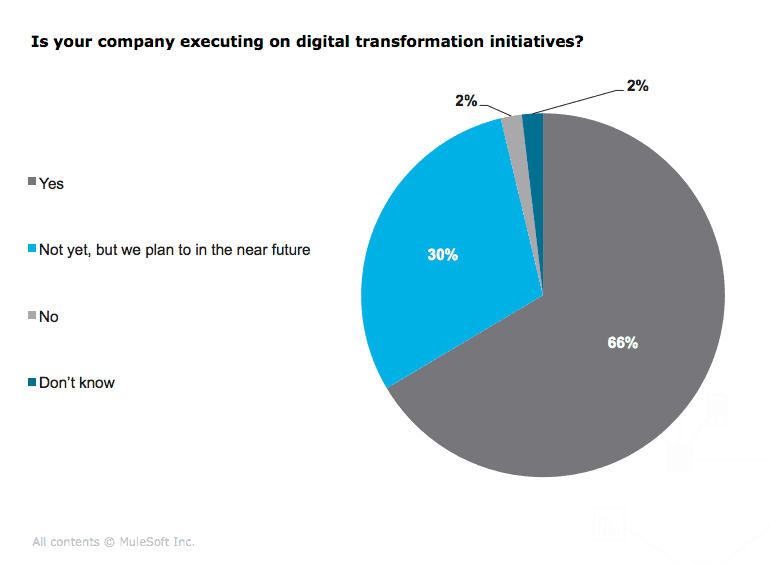How do companies innovate and digitally transform their business by using the same strategies, procurement and operating models and approaches to technology? They don’t. They have the same company, just with a flashy website or mobile app.
I had a meeting with a group of IT executives at a conglomerate in Southern Europe. The meeting was intellectually stimulating and provoked interesting discussions and actions to follow after the meeting. Even MuleSoft’s senior team was impressed with their vision and how forward-thinking the IT execs were.
Unfortunately, nothing happened since we had the meeting, other than me chasing up CIOs, which isn’t fun for the executives or us. This seemed bizarre to me since the executives quite openly admitted that “something had to change” and that “if [they] carried on down this path [they] wouldn’t reach [their] vision and so many opportunities would be missed.” The more experienced account executives in the emerging markets team at MuleSoft tell me this is quite common, since the relationships between IT, the business strategists, the C-suite, and other players, both internal and external, can be a lot more complex.
Although I appreciate different cultures and ways of doing business, I was surprised by the radio silence not because we didn’t stick to the initial plan but because one of the most senior members from the conglomerate had told us about his vision and that they were not going to achieve it with their current model. In fact, this IT leader even recommended reading the book by Marshall Goldsmith called What Got You Here Won’t Get You There, which is all about eliminating the bad habits that hinder individuals and companies from progression. The book was the theme of the meeting. Seems ironic right?

This is not just an emerging markets problem. In our above chart from our recent survey of 800 global IT decision makers, 66% is having difficulties executing on digital transformation initiatives. Our same report also tells that only 18 percent said they were “very confident” they could meet their digital transformation goals despite the fact that 84% stated that they would suffer negative consequences. These consequences include decreased revenue if they didn’t meet those goals in the next 12 months or sooner. Behavioral scientists call this irrational behavior, the “status quo bias.” The theory states that one of the humans’ limits on rationality is that they don’t make decisions based on their outcomes. This may sound counter-intuitive, but it means that people will not necessarily choose the better option with the best outcome, but rather choose the option that is most consistent with their existing path and conception of the world. In this case, that is this company’s usual procurement and engagement with traditional integration vendors. The bias is that the current model is the safest bet to go with despite the other options available. It might be labeled “irrational”, but it’s the same psychological reaction that keeps you from being fooled into investing in false investment opportunities online.
What’s slightly crazy here is that the IT executives admit that they need to change and that what MuleSoft is recommending makes sense. So the lack of action is because these thought-leaders of their respective domains, industries and markets were so overwhelmed by the status quo it seemed to supersede another bias —loss aversion. My initial thought was how can these super-smart guys not see that they were about potentially to lose years of innovation, new revenue streams, and growth? But when you think about the status quo bias it makes sense.
“Fear of missing out” or “fear of loss” is one of the biggest emotional motivators of human behavior; it overcomes rational decision making, in particular, the willingness to take risks to avoid loss. The IT executives feared to deviate from the status quo because they fear the loss it might bring them. It’s like a gambling addict who keeps playing at the roulette table after losing his savings because he’s afraid of being poor. He believes, if he stops gambling, he’s somehow more at risk of being poor than if he carries on.
This is happening at the highest levels of companies – the CEO, the COO, everyone. This conglomerate is not the only one. Almost every IT leader and executive I’ve spoken to at banks, retail chains, airlines and FMCG companies and it’s the same story: although they want to innovate and change, they want to do it using the same tools and business philosophies they’ve been using for the last 20 years.
The failure to innovate through new methods seems to be largely why companies like Blockbuster, Kodak, Pan-Am and HMV all failed to reinvent themselves. As an Account Executive at MuleSoft, one of the fastest growing technology companies of all time, I feel my key challenge will be showing companies how to minimize the risk and alleviate the fear from shifting away from the status quo. It should be our responsibility as thought leaders in this space to enable, educate, and guide companies through as they adapt and change.
For more information about why digital transformation is going wrong for ITDMs, check out our whitepaper.








